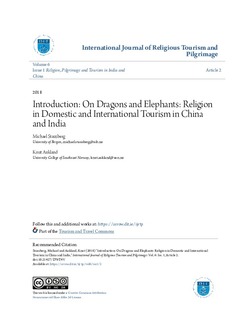| dc.contributor.author | Stausberg, Michael | |
| dc.contributor.author | Aukland, Knut | |
| dc.date.accessioned | 2019-01-28T09:40:33Z | |
| dc.date.available | 2019-01-28T09:40:33Z | |
| dc.date.created | 2018-06-06T12:22:25Z | |
| dc.date.issued | 2018 | |
| dc.identifier.citation | International Journal of Religious Tourism and Pilgrimage. 2018, 6 (1), 1-7. | nb_NO |
| dc.identifier.issn | 2009-7379 | |
| dc.identifier.uri | http://hdl.handle.net/11250/2582559 | |
| dc.description | This work is licensed under a Creative Commons Attribution-Noncommercial-Share Alike 3.0 License | nb_NO |
| dc.description.abstract | This introductory essay explores some of the commonalities and differences that emerge from reading this thematic issue on religion and tourism in China and India. Economic growth has led to an explosion in domestic tourism activity in both countries, and the respective states are deeply involved in this development. The Indian state sees tourism as a means to create jobs, revenue and regional development. While this is also true for the Chinese state, it further treats tourism as a means to control and manage religion. In both countries, official tourism development can lead to complete makeovers of particular sites as beautification projects and tight regulation drives out informal economies and change the religious dynamics on the ground. The local management, be it formal or informal, affects not only where the money flows, but also how temples are visited and gods worshiped. Buddhism related tourism plays a peculiar role in India, where the government employs it as a vehicle for articulating pan-Asian and even global aspirations. Asian Buddhists visit Indian Buddhist destinations in growing numbers[1]. At the same time, Buddhist sites attract a steady stream of Western tourists who are most comfortable labelling themselves as spiritual travellers. For these travellers, the notion of ‘tourism’ threatens sources of authentic spirituality. In China, tourism is contributing to a revival of religion, sometimes providing means for temple institutions to legitimate their religious activities. Self-professed secular domestic tourists in China routinely engage in short acts of veneration at Buddhist places of pilgrimage. In this respect, Han Chinese tourists appear not so different from their Hindu counterpart in India. Increasingly, Hindu visitors at sites of pilgrimage opt for short acts of worship, rather than long rituals. Travel guidebooks, however, paint different pictures: Chinese tourists are given practical advice and encouragement on the performance of rituals, and their representation of religion recalls orientalist tropes of Western guidebooks. Indian guidebooks, on their part, retain elements of traditional Hindu pilgrimage literature assuming that the reader has the required know-how of religious practices. The tourist imaginaries of the Global North, as expressed in English language guidebooks, still rest on Orientalist underpinnings when it comes to both India and China. | nb_NO |
| dc.description.abstract | On dragons and elephants: Religion in domestic and international tourism in China and India | nb_NO |
| dc.language.iso | eng | nb_NO |
| dc.rights | Navngivelse-Ikkekommersiell-DelPåSammeVilkår 3.0 Internasjonal | * |
| dc.rights.uri | http://creativecommons.org/licenses/by-nc-sa/3.0/deed.no | * |
| dc.title | On dragons and elephants: Religion in domestic and international tourism in China and India | nb_NO |
| dc.type | Journal article | nb_NO |
| dc.type | Peer reviewed | nb_NO |
| dc.description.version | publishedVersion | nb_NO |
| dc.rights.holder | © International Journal of Religious Tourism and Pilgrimage | nb_NO |
| dc.source.pagenumber | 1-7 | nb_NO |
| dc.source.volume | 6 | nb_NO |
| dc.source.journal | International Journal of Religious Tourism and Pilgrimage | nb_NO |
| dc.source.issue | 1 | nb_NO |
| dc.identifier.doi | 10.21427/D76T4V | |
| dc.identifier.cristin | 1589409 | |
| cristin.unitcode | 222,59,3,0 | |
| cristin.unitname | Institutt for kultur, religion og samfunnsfag | |
| cristin.ispublished | true | |
| cristin.fulltext | original | |
| cristin.qualitycode | 1 | |

